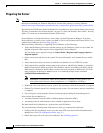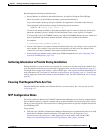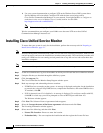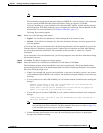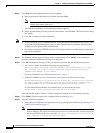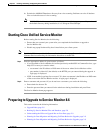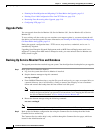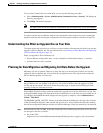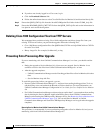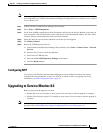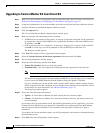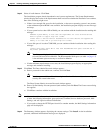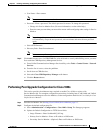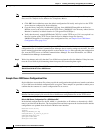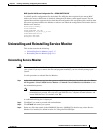
2-10
Installation Guide for Cisco Unified Service Monitor
OL-25111-01
Chapter 2 Installing, Uninstalling, and Upgrading Service Monitor
Preparing to Upgrade to Service Monitor 8.6
b. If you have not already logged in to Cisco.com, log in.
c. Click the Download Software link.
d. Follow the online instructions to select Cisco Unified Service Monitor 8.6 and download the zip file.
Step 2 Extract the QOVR_CMT.zip file from the \install\CallMigrationTool folder in the CUSM8_6.zip file.
Step 3 Extract the README_QOVR_CMT.TXT file from the QOVR_CMT.zip file and use the information in
it to plan for and execute the migration.
Deleting Cisco 1040 Configuration Files from TFTP Servers
We recommend that you delete existing Cisco 1040 configuration and binary image files from your
existing TFTP servers before you perform the upgrade. Delete the following files:
• Cisco 1040 Sensor configuration files: One QOVDefault.CNF file and a QoVMACAddress.CNF file
for each Cisco 1040.
• Binary image file: For example, SvcMonAA2_nn.img
Preventing Extra Processing After Upgrade
If you are monitoring calls from Unified Communications Manager 6.x or later, you should consider
that:
• During the upgrade to Service Monitor 8.6, all processes are stopped. Service Monitor is not
available to receive data files from Unified Communications Manager 6.x or later.
• After the upgrade completes:
–
Unified Communications Manager sends all backlogged data files to Service Monitor; this takes
time.
–
Service Monitor drops old files.
To avoid this processing, before you upgrade, you can:
• Prevent Unified Communications Manager 7.x and later from sending backlogged data. To do so,
edit the billing server and uncheck the Resend on Failure check box. For more information, see
Unified Communications Manager Configuration in User Guide for Cisco Unified Service Monitor
8.6.
• For Unified Communications Manager software releases earlier than 7.x, prevent them from sending
data by deleting the Service Monitor Application Billing Server from Unified Communications
Manager and restarting the CDR Repository Manager service. See Removing Service Monitor from
Unified Communications Manager, page 2-10. You can add Service Monitor to Unified
Communications Manager and restart the CDR Repository Manager service again after the upgrade
completes.
Removing Service Monitor from Unified Communications Manager
This procedure is recommended if you are performing an upgrade to Service Monitor 8.6 and you are
monitoring calls from Unified Communications Manager 6.x.



